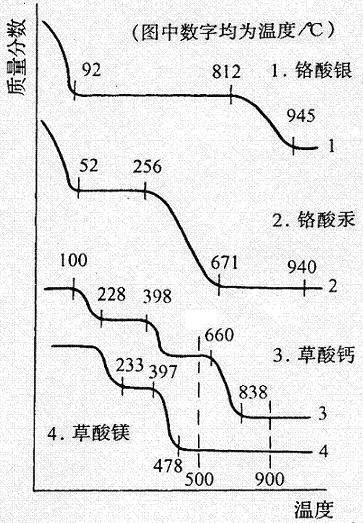热重分析一般用啥方法测试
2023-01-08热重分析一般用什么方法测试
热重分析一般把样品放入铝坩埚,放入样品之前和之后,都要放在天平上称重,获得样品重量,获得重量的目的是使样品重量适合于尽可能高的热失重精度。样品放入后,要在专用压片机上将坩埚盖与坩埚压合起来,主要防止样品在加热过程中被热分解气流或热分解迸射弹出坩埚,对实验造成非热分解性重量减失。 样品坩埚放入热重分析仪的样品炉内,同时在参比炉内放入参比样品或者不放参比物的空坩埚,参比物如氧化铝粉末,也要放入铝坩埚并进行压盖密封。参比物是选用在所测温度段没有任何热效应的、热稳定的物质。 设定升温速率、结束温度等参数,就可以开始实验了。一般都是自动进行的。热重分析仪中有测重设备和电子线路。随着温度上升、样品质量的变化,仪器把样品温度和样品重量的数据即时地记录下来,这就是热重曲线(TG)或者把样品温度和重量对时间(也是对温度,因为一般升温速率是等速的)的微分曲线(DTG)记录下来,成为热重曲线或微分热重曲线。 几个样品的热重分析曲线放在附图,给你有一个感性认识。曲线上的数字是温度值。 
ANSI/ASTM D6375-2009 用热重分析仪(TGA)测定润滑油蒸发损耗的试验方法(Noack法) Test Method for Evaporation Loss of Lubricating Oils by Thermogravimetric Analyzer (TGA) (Noack Method)
ASTM D6382-1999(2005) 屋顶和防水屋顶膜材料的热重力和动态机械分析的标准操作规程 Standard Practice for Dynamic Mechanical Analysis and Thermogravimetry of Roofing and Waterproofing Membrane Material
ASTM E2402-2005 热重分析仪的质量损耗和剩余量测量验证的标准试验方法 Standard Test Method for Mass Loss and Residue Measurement Validation of Thermogravimetric Analyzers
ASTM E2551-2007 和热重分析仪一起使用的湿度发生器湿度校正(或构型)的标准试验方法 Standard Test Method for Humidity Calibration (or Conformation) of Humidity Generators for Use with Thermogravimetric Analyzers
ASTM E2550-2007 热重分析法测定热稳定性的标准试验方法 Standard Test Method for Thermal Stability by Thermogravimetry
ASTM E1641-2007 用热重分析法的分解动力学用标准试验方法 Standard Test Method for Decomposition Kinetics by Thermogravimetry
ASTM E2043-1999(2006) 热重分析法测量农业辅助剂溶液中不挥发物质的标准试验方法 Standard Test Method for Nonvolatile Matter of Agricultural Adjuvant Solutions by Thermogravimetry
BS EN 60811-4-1-2004 电缆和光缆的绝缘和护套材料.通用试验方法.聚丙烯和聚丙烯化合物专用方法.抗环境应力致裂.熔化流动指数测量 Insulating and sheathing materials of electric and optical cables - Common test methods - Methods specific to polypropylene and polypropylene compounds - Resistance to environmental stress cracking - Measurement of the melt flow index - Carbon black and/or mineral filter content measurement in PE by direct combustion - Measurement of carbon black content by TGA - Assessment of carbon black dispersion in polyethylene using a microscope
BS ISO 12989-2-2005 铝生产用碳素材料.焙烧阳极和侧壁块.空气反应性的测定.热重分析法 Carbonaceous materials used in the production of aluminium - Baked anodes and sidewall blocks - Determination of the reactivity to air - Thermogravimetric method
BS EN ISO 11358-1997 塑料.聚合物的热重分析法(TG).一般原理 Plastics - Thermogravimetry (TG) of polymers - General principles
BS ISO 11358-2-2005 塑料.高聚物的热重分析法(TG).活化能测定 Plastics - Thermographimetry (TG) of polymers - Determination of activation energy
BS ISO 21870-2005 橡胶配合剂.炭黑.热重分析法测定加热的高温损失 Rubber compounding ingredients - Carbon black - Determination of high-temperature loss on heating by thermogravimetry
BS ISO 9924-3-2009 橡胶和橡胶产品.利用热重量分析法测定硫化橡胶和混炼胶料的成分.提取后的烃类橡胶,卤化橡胶和聚硅氧烷橡胶 Rubber and rubber products - Determination of the composition of vulcanizates and uncured compounds by thermogravimetry - Hydrocarbon rubbers, halogenated rubbers and polysiloxane rubbers after extraction
DIN EN ISO 11358-1997 塑料.聚合物的热重测定.一般原理 Plastics - Thermogravimetry (TG) of polymers - General principles (ISO 11358:1997); German version EN ISO 11358:1997
IEC 60811-4-1-2004 电缆和光缆绝缘和护套材料的通用试验方法.第4-1部分:聚乙烯和聚丙烯化合物专用方法.抗环境应力致裂.熔化流 Insulating and sheathing materials of electric and optical cables - Common test methods - Part 4-1: Methods specific to polyethylene and polypropylene compounds - Resistance to environmental stress cracking - Measurement of the melt flow index - Carbon black and/or mineral filler content measurement in polyethylene by direct combustion - Measurement of carbon black content by thermogravimetric analysis (TGA) - Assessment of carbon black dispersion in polyethylene using a microscope
ISO 11358-2-2005 塑料.高聚物的热重分析法(TG).第2部分:活化能测定 Plastics - Thermogravimetry (TG) of polymers - Part 2: Determination of activation energy
ISO 11358-1997 塑料 高聚物的热重分析法(TG) 一般原则 Plastics - Thermogravimetry (TG) of polymers - General principles
ISO 12989-2-2004 铝生产用碳素材料.焙烧阳极和部碳块.空气反应性的测定.第2部分:热重分析法 Carbonaceous materials used in the production of aluminium - Baked anodes and sidewall blocks - Determination of the reactivity to air - Part 2: Thermogravimetric method
ISO 21870-2005 橡胶配合剂.炭黑.热重分析法测定加热下的高温损失 Rubber compounding ingredients - Carbon black - Determination of high-temperature loss on heating by thermogravimetry
ISO 9924-3-2009 橡胶和橡胶制品.用热重量分析法测定硫化和未硫化化合物的成分.第3部分:烃类橡胶、卤化橡胶和萃取后聚硅醚橡 Rubber and rubber products - Determination of the composition of vulcanizates and uncured compounds by thermogravimetry - Part 3: Hydrocarbon rubbers, halogenated rubbers and polysiloxane rubbers after extraction
JIS K7120-1987 塑料热重量分析法的测试方法 Testing methods of plastics by thermogravimetry
JIS K6226-2-2003 橡胶和橡胶制品.用热重量分析法测定硫化橡胶和未硫化化合物的成分.第2部分:丙烯腈丁二烯和卤丁基橡胶 Rubber and rubber products -- Determination of the composition of vulcanizates and uncured compounds by thermogravimetry -- Part 2: Acrylonitrile-butadiene and halobutyl rubbers
JIS K6226-1-2003 橡胶和橡胶制品.用热重分析法测定硫化和未硫化化合物的成分.第1部分:丁二烯、乙烯-丙烯共聚物和三聚物、异 Rubber and rubber products -- Determination of the composition of vulcanizates and uncured compounds by thermogravimetry -- Part 1: Butadiene, ethylene-propylene copolymer and terpolymer, isobutene-isoprene, isoprene and styrene-butadiene rubbers